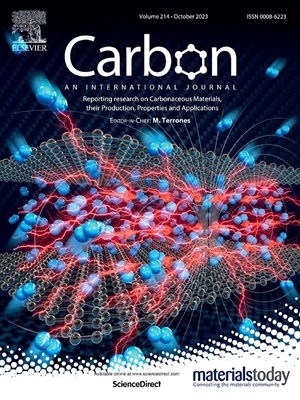镀镍丝状碳的电磁干扰屏蔽性能研究进展
IF 10.5
2区 材料科学
Q1 CHEMISTRY, PHYSICAL
引用次数: 0
摘要
本文综述了镍包覆碳纤维(CF)、碳纳米纤维(CNF)和碳纳米管(CNT)的电磁干扰(EMI)屏蔽性能。镍涂层降低了电阻率并提供了磁性,通过吸收增强了屏蔽。吸收损耗SEA大于反射损耗SER。CF可以是连续的,也可以是不连续的,而CNF和CNT是不连续的。连续CF比非连续CF具有更高的屏蔽效率,即使没有镍涂层,连续CF复合材料的屏蔽效率也高达125 dB (1-2 GHz),接近测量极限,高于任何非连续形式的镍涂层长丝碳。通过施加磁场,可以实现不连续CF的择优取向。连续CF适用于精确的方向控制,包括平面线圈和线性配置。平面线圈结构强调了镍涂层对屏蔽的积极作用。碳纳米管和碳纳米管具有很高的比表面积,由于集肤效应而增强了屏蔽作用。在不连续的丝状碳中,镍包覆CNF的屏蔽效果最高,为87 dB (1-2 GHz)。该材料含94.4 vol% Ni,直径0.4 μm, CNF芯直径0.1 μm。镍涂层碳纳米管提供的最高屏蔽效率为69 dB (8 GHz),而没有涂层的屏蔽效率为50 dB。镀镍不连续CF提供的最高屏蔽效能为80 dB (0.03-1.2 GHz)。本文章由计算机程序翻译,如有差异,请以英文原文为准。

A perspective on the electromagnetic interference shielding behavior of nickel-coated filamentary carbons
This perspective provides a critical review of the electromagnetic interference (EMI) shielding behavior of nickel-coated filamentary carbons, including carbon fiber (CF), carbon nanofiber (CNF) and carbon nanotube (CNT). The nickel coating decreases the resistivity and provides magnetic character, which enhances shielding through absorption. The absorption loss SEA dominates over the reflection loss SER. The CF can be continuous or discontinuous, whereas CNF and CNT are discontinuous. The continuous CF gives higher shielding effectiveness than discontinuous CF. Even without the nickel coating, continuous CF composites exhibit shielding effectiveness as high as 125 dB (1–2 GHz), which approaches the measurement limit and is higher than that of any discontinuous form of nickel-coated filamentary carbon. Preferred orientation of the discontinuous CF can be achieved by magnetic field application. Continuous CF is amenable to precise orientation control, including planar coil and linear configurations. The planar coil configuration accentuates the positive effect of the nickel coating on the shielding. The CNF and CNT are attractive for their high specific surface area, which enhances shielding because of the skin effect. Among the discontinuous filamentary carbons, nickel-coated CNF gives the highest shielding effectiveness of 87 dB (1–2 GHz). This material contains 94.4 vol% Ni, with diameter 0.4 μm and CNF core diameter 0.1 μm. The highest shielding effectiveness provided by nickel-coated CNT is 69 dB (8 GHz), compared to 50 dB without the coating. The highest shielding effectiveness provided by nickel-coated discontinuous CF is 80 dB (0.03–1.2 GHz).
求助全文
通过发布文献求助,成功后即可免费获取论文全文。
去求助
来源期刊

Carbon
工程技术-材料科学:综合
CiteScore
20.80
自引率
7.30%
发文量
0
审稿时长
23 days
期刊介绍:
The journal Carbon is an international multidisciplinary forum for communicating scientific advances in the field of carbon materials. It reports new findings related to the formation, structure, properties, behaviors, and technological applications of carbons. Carbons are a broad class of ordered or disordered solid phases composed primarily of elemental carbon, including but not limited to carbon black, carbon fibers and filaments, carbon nanotubes, diamond and diamond-like carbon, fullerenes, glassy carbon, graphite, graphene, graphene-oxide, porous carbons, pyrolytic carbon, and other sp2 and non-sp2 hybridized carbon systems. Carbon is the companion title to the open access journal Carbon Trends. Relevant application areas for carbon materials include biology and medicine, catalysis, electronic, optoelectronic, spintronic, high-frequency, and photonic devices, energy storage and conversion systems, environmental applications and water treatment, smart materials and systems, and structural and thermal applications.
 求助内容:
求助内容: 应助结果提醒方式:
应助结果提醒方式:


